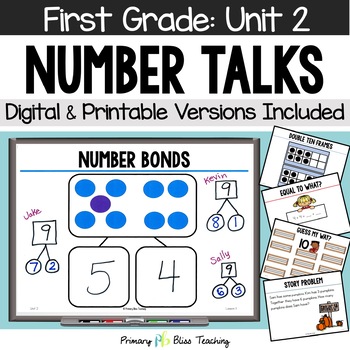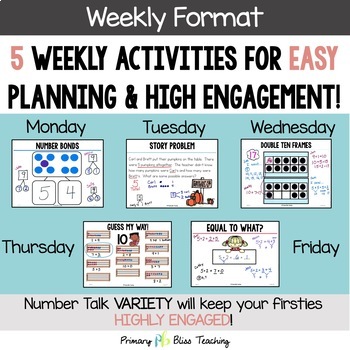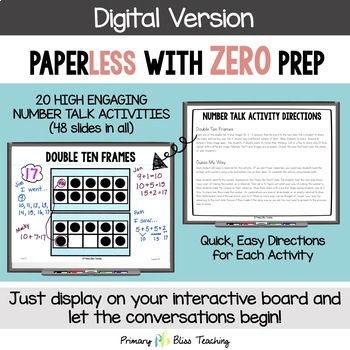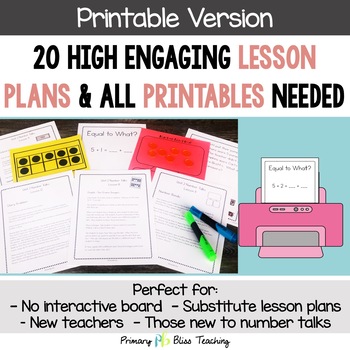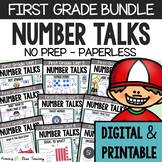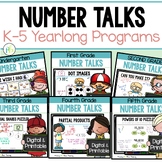First Grade Number Talks Unit 2 for Building Number Sense and Mental Math
- Zip
- Google Apps™

What educators are saying
Also included in
- Math Talks are hands-down the best math warm-up activities for developing number sense and computational fluency. And these Number Talks for first grade make implementing Number Talks easier than ever.This seriously NO PREP resource provides daily lessons that are thought-provoking and engaging forPrice $37.00Original Price $49.50Save $12.50
- MATH TALKS are hands-down the BEST math warm-up activities out there for developing NUMBER SENSE and COMPUTATIONAL FLUENCY. And these PAPERLESS Number Talks for grades K-5 make implementing Number Talks EASIER than ever. This seriously NO PREP resource provides DAILY lessons that are thought-provokiPrice $210.00Original Price $304.00Save $94.00
Description
This 1st grade Number Talks resource is a MUST-HAVE for any teacher wanting their students' computational strategies and mathematical reasoning abilities to soar to new heights.
You'll be thrilled as you observe your students' mental math abilities grow to be stronger than ever.
If you are looking for an engaging and meaningful NO PREP daily math warm-up, this is it! These Number Talks are ready to go. Just display them on your interactive whiteboard and get ready for amazing math conversations to begin.
This resource is a huge TIME SAVER and will give you the biggest bang for your buck!
We've got you covered if you don't yet have an interactive whiteboard. With this resource, you'll receive both a DIGITAL and a PRINTABLE version.
The BEST part is it's EXTREMELY EASY to use and will SAVE you TONS of TIME.
There are 5 activities that students repeat over a 4-week time frame. This makes life oh so easy for teachers, and gives students repeated opportunities to engage in each particular number talk activity.
Our students LOVE this daily routine! We just know your students will too!
==============================================================================
THIS UNIT INCLUDES:
- 20 Highly Engaging Common Core Aligned Number Talks Lessons: The DIGITAL version is no prep and ready to go. The printable version only requires that you print and, at times, cut.
- Easy Differentiation: Several of the lessons contain more than one Number Talk option for easy-peasy differentiation. There are 57 slides in all.
- Variety of Number Talks Activities: Say "YES" to high engagement and "NO!" to boredom!
This product contains the following activities that you can rinse and repeat Monday through Friday or tailor to your own number talk routine:
- Monday - Number Bonds - 4 slides/pages
- Tuesday - Story Problems - 4 slides/pages
- Wednesday - Double Ten Frames - 12 slides/pages
- Thursday - Guess My Way - 4 slides/pages
- Friday - Equal to What? - 8 slides/pages
- Detailed Daily Lesson Plans: We have spelled out exactly how to deliver each Number Talk so you can teach these with ease right away. The lesson plans are GREAT for teachers new to Number Talks, substitute teachers, and teachers who do not have interactive whiteboards.
==============================================================================
BONUSES!:
- 7 Colorful Sentence Starter Posters to give your students confidence while sharing their thinking.
- 8 Silent Hand Signal Posters to increase student engagement as all students can communicate their thinking in a way that does not disrupt the learning environment.
- A link to a GOOGLE SLIDES version is included.
========================================================================
HERE'S WHAT OTHER TEACHERS ARE SAYING!
"Love the themed number talks activities. Changing the activities daily keep my students interested. This also shows different concepts our math series doesn't use." -Michelle
"Thank you for this great resource. I am new to number talks and this really helped! Thinking about getting your other Number Talks. -Lindsay
"This may be my favorite TPT product ever! I've seen so much growth in my kids' number sense!" -Emily
"My kids have been so engaged with this resource and they now look forward to our daily number talks." -Katie
==============================================================================
Why NUMBER TALKS?...
Number Talks will get your students engaged in mathematical conversations that will increase their ability to reason mathematically as well as develop their computational fluency skills and their ability to think flexibly about numbers.
But the BEST benefit is that they'll turn your reluctant mathematicians into math lovers!
When students engage in this short daily activity, they communicate with their peers in a safe environment where it's okay to not be right all the time. It's okay to learn from each other.
Your students will learn to discuss various strategies, as well as how and why they work.
They'll begin to take risks. And before you know it, your students who once feared math will joyfully jump into solving problems with both feet.
It's so exciting to see the transformation!
==============================================================================
WHY DID WE CREATE THIS RESOURCE?
A few years ago we were asked to implement Number Talks in our daily math instruction. After engaging our students in a few of these activities, we were hooked. Our challenge then became to create a variety of problem types in order to keep students engaged and excited. And that is when this Number Talk program was born.
==============================================================================
WHO IS THIS RESOURCE FOR?
-Busy First Grade Teachers
-Substitute Teachers
-Special Education Teachers
-Whole Group Math Instruction
-Small-Group Math Instruction
-Math Intervention
==============================================================================
FAQ
How long do Number Talks take?
It's best if Number Talks are done daily for between 5 and 15 minutes.
Can these Number Talks be displayed on an interactive whiteboard?
YES! There's a fully digital version of our number talks using PowerPoint for your convenience! Just display them and go! This makes implementing Number Talks so easy!
Does each month contain 20 different types of Number Talk activities?
Oh goodness no. That would be a bit overwhelming. We have 5 Number Talk activities that are repeated each week using different problems. We are all about keeping it easy for teachers and creating meaningful engagement for kids.
Do I have to print out Number Talk materials for each student each day?
NO! This is a whole group activity. Just display the Number Talk for everyone to see.
Do I need to teach the units in order?
We suggest you teach the Number Talks in order because they spiral and increase in difficulty.
Where are the daily lesson plans?
Daily lesson plans are in the printable version section. These are GREAT for teachers new to Number Talks as well as for substitute teachers.
==============================================================================
Other NUMBER TALKS Resources You'll Love:
First Grade Yearlong Number Talks BUNDLE
First Grade Number Talks Unit 1
First Grade Number Talks Unit 3
First Grade Number Talks Unit 4
First Grade Number Talks Unit 5
First Grade Number Talks Unit 6
First Grade Number Talks Unit 7
First Grade Number Talks Unit 8
First Grade Number Talks Unit 9
========================================================================
Click HERE to follow us and receive notifications for SALES, FABULOUS NEW RESOURCES, and FREEBIES!
========================================================================
FREE $$$ - LEAVE FEEDBACK on this product to earn TPT credits that can be used on future purchases!
==============================================================================
Having tech difficulties?
Please SUBMIT a help ticket, TpT has an AMAZING tech team.
==============================================================================
Copyright © Primary Bliss Teaching
Permission to copy for single classroom use only.
Please purchase additional licenses if you intend to share this product.
Becky & Cindy
Team Primary Bliss Teaching

